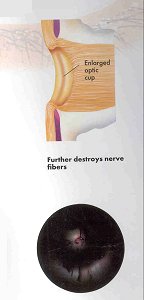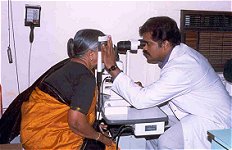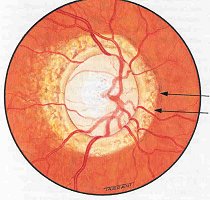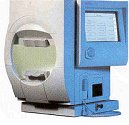|
PATIENT EDUCATION
PROGRAME (PEP TALK) SERIES-1 - GLAUCOMA
A
SILENT BLINDING OCULAR DISEASE WE SHOULD KNOW
Glaucoma
is a condition of progressive optic neuropathy in which the fluid
pressure inside the eye is sufficiently elevated to result in damage to
the optic nerve head and thereby producing peripheral visual field loss.
This condition commonly affects people between 30 to 60yrs of age although
even newborn (congenital glaucoma) and the young (Juvenile Glaucoma) are
also affected by this condition.The causes of Glaucoma can be broadly classified
into primary (cause not exactly known) and secondary type (due to a known
pre-existent ocular pathology).There are more than 40 subtypes of
glaucoma and the basic mechanisms are either due to increased production
of the intraocular fluid - aqueous or its decreased excretion
out of the eye.It is to be noted that nearly 1% of our Indian population
(1 million people) are affected with this disease. Glaucoma is the second
largest (accounts for about 12%) cause of preventable blindness in
our country next to cataract.

|

|
|
Normal
Picture with Normal field of vision
|
Glaucomatous
damage to the optic nerve head results in constriction of the peripheral
of the vision
|
Who
are at Risk ?
Exact
cause for Primary Glaucomas are unknown. Predisposing factors include:
-
Patients
with family history of glaucoma (maternal/paternal background).
-
Patients
with high intra ocular pressures (Ocular hypertensives)
-
Patients
belonging to the dark race population (Asians and Africans).
-
Increasing
age and patients with high myopia.
-
Patients
with systemic illnesses - diabetes, hypertension, asthma, heart failure,
-
History
of long term steroid drug intake for asthma and arthritis.
-
Patients
who are obese and chronic alcoholics are prone to have high intraocular
pressures leading to glaucoma.Patients on long term specific Psychiatric
medications - anti depressants and sedatives.
Known
ocular causes (Secondary Glaucoma variety)
-
Associated
congenital abnormalities, high hypermetropic refractive error.
-
History
of repeated attacks of pain and redness in the eyes (Uveitis)
-
Blunt
injury to the eye can cause angle recession glaucoma.
-
Long standing
mature cataract causes lens induced glaucomas
-
Post-operative
complications after intraocular surgeries
When
to suspect
Most
of the patients are asymptamatic (hence Glaucoma is a “silent blinder”).
However few symptoms like ocular tightness or pain with associated headache,
browache, seeing rainbow coloured rings around the advancing vehicle head
lights, electric bulbs, frequent change of glasses and frequent complaints
by the relatives of patients being unaware of the surrounding objects existent.
What
to do next with raised Intraocular pressure
Once
ocular hypertension is detected, a detailed ophthalmic examination is done
to rule out glaucomatous damage to the optic nerve head. Stereobiomicroscopic
evaluation of the optic nerve and fundus is done. Careful Gonioscopic examination
of the drainage angle is done to differentiate open angle from a narrow
angle glaucoma. Peripheral visual field testing using the Humphrey Automated
perimeter detects earliest field loss. Optic disc photography is done every
year to compare the progression of the disease. It should be realized
and explained to the patient that the glaucomatous damages that have already
occurred at the time of detection cannot be reversed and further evaluation
and treatment are instituted only to preserve the existing vision and safeguard
against further progression of the disease.

|

|
| Recording
Intraocular pressure |
Fundus
examination of the optic nerve head for glaucomatous changes |
|

|

|
| HFA
Machine for recording peripheral visual field |
Visual
field report |
-
These
test are done every one year to follow up progressive of the disease
|
Treatment
Protocol Once diagnosed, treatment with antiglaucoma tablets and eye drops
are started to bring down the target intraocular pressures by 30-40%
of the original value. Alternatively, surgical procedures or Laser treatment
are advised if necessary to permanently bring down the intraocular pressures
within safe tolerable limits.
Coimbatore.
|



